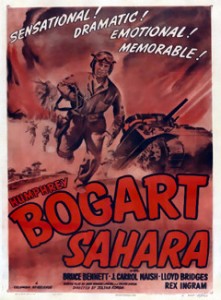A mighty story of adventure, courage and glory in the desert!…tender human emotion…triumphant action…matchless thrills…a memorable entertainment experience!
The film is a pretty standard tale of a lost tank crew (commanded by Bogart) attempting to rejoin their lines. Along the way they pick up a veritable baker’s dozen of other folks, including British soldiers, a Sudanese soldier, and a Free French Soldier. They also take prisoner, so to speak, both an Italian soldier and a German fighter pilot. I say so to speak because the Italian is portrayed as a well meaning but weak minded former enemy.
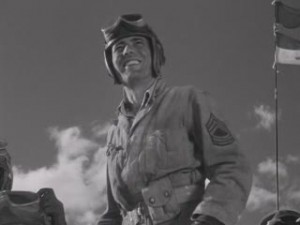 About the time old LullaBelle (the name of the tank) gets overburdened with people, they realize they are just about out of water. Oh, and perhaps I forgot to mention that the film takes place in the Sahara desert during the North African Campaign just prior to El Alamein. So water could be of some import here.
About the time old LullaBelle (the name of the tank) gets overburdened with people, they realize they are just about out of water. Oh, and perhaps I forgot to mention that the film takes place in the Sahara desert during the North African Campaign just prior to El Alamein. So water could be of some import here.
Eventually the parched group finds an almost dry well at some abandoned ruins. While they are there filling their canteens and other various vessels, the well runs dry and a German Battalion appears on the horizon also looking for water.
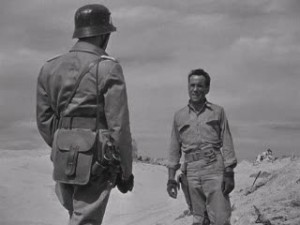 Rather than running this band, on Bogart’s suggestion, decides to make a stand to defend the well of now non-existent water. The motley bunch kills many weary German soldiers (except those supermen who can have a tank shell explode RIGHT next to them and keep on running unscathed) but at the cost of almost their own entire group.
Rather than running this band, on Bogart’s suggestion, decides to make a stand to defend the well of now non-existent water. The motley bunch kills many weary German soldiers (except those supermen who can have a tank shell explode RIGHT next to them and keep on running unscathed) but at the cost of almost their own entire group.
After a few rounds of talks under the white flag, the Germans make a final charge, or do they? In the closing scenes the remaining several hundred Germans surrender to the two remaining allied soldiers who are then discovered by a British search party as the curtain falls.
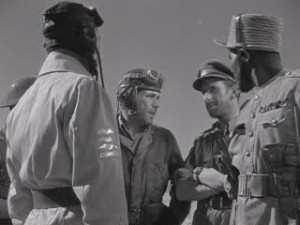 Nothing overly deep here and the propaganda elements of the film are hard to overlook. The United Nations feel of Bogart’s Band of Brothers including their very sympathetic Italian prisoner array themselves very nicely against the stereotypically evil Germans. It’s important to note that during production of this film the Italians were in the process of switching sides- hence they couldn’t be portrayed as arm in arm with the Germans, but not quite driving LullaBelle yet either.
Nothing overly deep here and the propaganda elements of the film are hard to overlook. The United Nations feel of Bogart’s Band of Brothers including their very sympathetic Italian prisoner array themselves very nicely against the stereotypically evil Germans. It’s important to note that during production of this film the Italians were in the process of switching sides- hence they couldn’t be portrayed as arm in arm with the Germans, but not quite driving LullaBelle yet either.
There are many speeches of varying lengths which quite bluntly address the war and why nations from around the world fought the Nazi scourge. These make it a bit melodramatic but Bogart’s reading of his killed comrades dog tags is almost maudlin. One has to simply look past this preachiness and enjoy the plot and the acting. Remember we were trying to sell war bonds at the time and it’s easier to swallow.
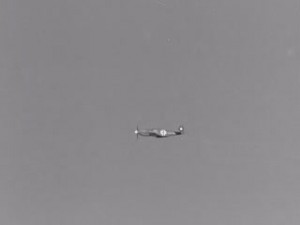 Technically there are a few goofs, but most of which are pretty easily explained. The German plane which strafes Lullabelle is in fact and American fighter which has been repainted (most likely a P51). It’s ironic that the German plane makes several strafing runs with no effect whatsoever- except the fatal shooting of an American soldier played by Lloyd Bridges- who doesn’t visibly appear during the strafing attacks.
Technically there are a few goofs, but most of which are pretty easily explained. The German plane which strafes Lullabelle is in fact and American fighter which has been repainted (most likely a P51). It’s ironic that the German plane makes several strafing runs with no effect whatsoever- except the fatal shooting of an American soldier played by Lloyd Bridges- who doesn’t visibly appear during the strafing attacks.
However, in one shot with its main gun Lullabelle downs the fighter. Given the impossible elevation this would have required for the gun not to mention the entire question of accuracy this is a bit ludicrous- but again we need that German pilot to complete our posse.
Also the helmets the Germans wear here are not World War II vintage, but rather World War I, which, although similar, are different. The question of both the helmets and the plane is simply answered by the fact that in 1943 the real thing was quite hard to come by. (Imagine the terror a fully operational Me109 fighter in the Mojave Desert would have conjured up to unknowing passersby.)
Overlook the preachiness at times and enjoy the action and the acting. Sahara has a great story and Bogart comes in with a strong performance. One has to wonder why Warners would loan out perhaps their biggest star (having just finished The Maltese Falcon, Casablanca, and High Sierra) to second rate studio Columbia?
Highly recommended.
